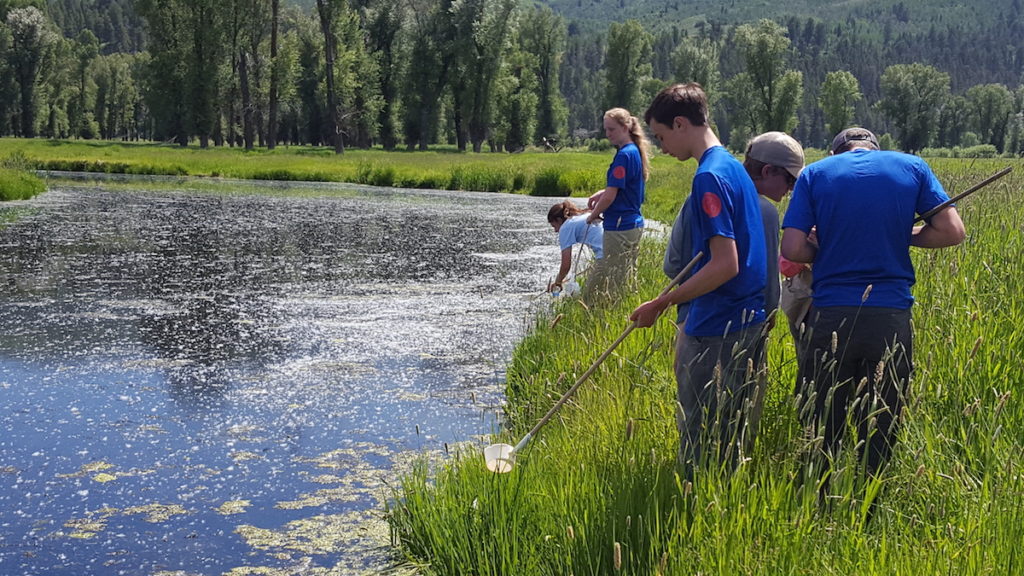A new citizen science initiative will be launched this summer to better inform land management decisions in the heavily used Cache Creek drainage. The project is called the Neighbors to Nature: Cache Creek Study and will establish a four-way partnership between the U.S. Forest Service’s Bridger-Teton National Forest, Friends of Pathways, Jackson Hole Wildlife Foundation and The Nature Conservancy’s Wildflower Watch.
Last week, project partners received word from the U.S. Forest Service’s Ecosystem Management Coordination staff in Washington, DC and their Office of Sustainability and Climate that Neighbors to Nature: Cache Creek Study was selected to receive a $25,000 grant from the Citizen Science Competitive Funding Program. Out of a total of 172 proposals received nation-wide, Neighbors to Nature: Cache Creek Study is one of just six proposals to be awarded funding.
The project will recruit a youth crew from Friends of Pathways (FOP), volunteers from the Jackson Hole Wildlife Foundation’s (JHWF) Nature Mapping Jackson Hole program, and volunteers from The Nature Conservancy’s (TNC) Wildflower Watch. These citizen scientists will collect, analyze and interpret plant, wildlife, and trail use data. The information collected will help establish a baseline of observations, as well as an effective and consistent method to gather and process this data over time. Forest Supervisor Tricia O’Connor said that this project will help achieve the goal for the Cache Creek area to serve as an outdoor classroom and deepen the connection between people and nature. She also noted that the project will help local managers by providing an accurate, scientific view of the plant and wildlife populations in the area, as well as improved information about recreation use.

The Friends of Pathways youth crew in Jackson, Wyoming will become citizen scientists for the National Forest
Approximately 10 species of native and invasive plants will be located and monitored by volunteers, and trail counters will be purchased and installed in key locations to observe how the area is being used for recreation. Some volunteers will directly observe and report on wildlife movements in the area, which can be used to evaluate how recreation use may be influencing wildlife behavior and inform management actions such as seasonal restrictions. Phenological observations such as leaf-out, budding, and flowering of plant species will help monitor the effects of climate change on plant communities and track invasive species. Data will then be analyzed and provided to the public at large and the U.S. Forest Service to inform future management decisions in the area.
ABOUT FRIENDS OF PATHWAYS
Friends of Pathways (FOP) works closely with the town, county and federal land management agencies to advocate for sustainable transportation and healthy recreation opportunities in Jackson Hole. Over the last four years its Youth Trail Crew has employed local high school students to work in partnership with the Bridge-Teton National Forest on trail maintenance, rehab projects, and data collection. This year the crew will be trained by Nature Mapping Jackson Hole to record wildlife they encounter while at work on the trails each day. They will also work with The Nature Conservancy’s Wildflower Watch to record phenological observations at key sites. Finally, they will help to collect usage data from trail counters and perform surveys to determine the types of users on the trails. For more information visit www.friendsofpathways.org
ABOUT THE NATURE CONSERVANCY
The Nature Conservancy’s Wildflower Watch invites volunteer citizen scientists to join in the study of how climate change may be affecting local plants and wildlife. Specifically our volunteers will record “phenology” or the seasonal timing of events – such as first flowering dates for several wildflower species. Powered by this research and education, we can work with public and private partners to prevent these impacts from becoming serious problems. This is a great way for individuals to take action to protect the places and creatures we love, beginning in our own backyard. The Nature Conservancy is a global conservation organization dedicated to conserving the lands and waters on which all life depends. Guided by science, we create innovative, on-the-ground solutions to our world’s toughest challenges so that nature and people can thrive together. In Wyoming, we are conserving lands, waters, wildlife and the Wyoming way of life. For more information, visit www.nature.org/wyoming.
ABOUT BRIDGER-TETON NATIONAL FOREST
The National Forests exist to care for the land and serve people by sustaining the health, diversity and productivity of the nation’s forests and grasslands for present and future generations. The core concept for management is the sustainability of resources to provide for the greatest good for the greatest number of people in the long run. As an integral part of the Greater Yellowstone Ecosystem, the Bridger-Teton offers more than 3.4 million acres of public land for memorable wildlife, wild land, water, and diverse recreation experiences, notably during the winter. For the Neighbors to Nature project, the Bridger-Teton National Forest will help facilitator the partnership, provide guidance to ensure information will be useful to land managers, and assist with reporting and sharing information with the public. For more information, visit www.fs.fed.us/r4/btnf
